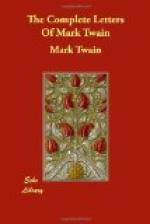The reader who has followed these pages has seen how prone Mark Twain was to fall a victim to the lure of a patent-right—how he wasted several small fortunes on profitless contrivances, and one large one on that insatiable demon of intricacy and despair, the Paige type-setter. It seems incredible that, after that experience and its attending disaster, he should have been tempted again. But scarcely was the ink dry on the receipts from his creditors when he was once more borne into the clouds on the prospect of millions, perhaps even billions, to be made from a marvelous carpet-pattern machine, the invention of Sczezepanik, an Austrian genius. That Clemens appreciated his own tendencies is shown by the parenthetic line with which he opens his letter on the subject to Mr. Rogers. Certainly no man was ever a more perfect prototype of Colonel Sellers than the creator of that lovely, irrepressible visionary.
To Mr. Rogers, in New York:
March
24, ’98.
Dear Mr. Rogers,—(I feel
like Col. Sellers).
Mr. Kleinberg [agent for Sczezepanik] came according to appointment, at 8.30 last night, and brought his English-speaking Secretary. I asked questions about the auxiliary invention (which I call “No. 2 “) and got as good an idea of it as I could. It is a machine. It automatically punches the holes in the jacquard cards, and does it with mathematical accuracy. It will do for $1 what now costs $3. So it has value, but “No. 2” is the great thing(the designing invention.) It saves $9 out of $10 and the jacquard looms must have it.
Then I arrived at my new project, and said to him in substance, this:
“You are on the point of selling the No. 2 patents to Belgium, Italy, etc. I suggest that you stop those negotiations and put those people off two or three months. They are anxious now, they will not be less anxious then—just the reverse; people always want a thing that is denied them.
“So far as I know, no great world-patent has ever yet been placed in the grip of a single corporation. This is a good time to begin.
“We have to do a good deal of guess-work here, because we cannot get hold of just the statistics we want. Still, we have some good statistics—and I will use those for a test.
“You say that of the 1500 Austrian textile factories, 800 use the jacquard. Then we will guess that of the 4,000 American factories 2,000 use the jacquard and must have our No. 2.
“You say that a middle-sized Austrian factory employs from 20 to 30 designers and pays them from 800 to 3,000 odd florins a year—(a florin is 2 francs). Let us call the average wage 1500 florins ($600).
“Let us apply these figures (the low wages too) to the 2,000 American factories—with this difference, to guard against over-guessing; that instead of allowing for 20 to 30 designers to a middle-sized factory, we allow only an average of 10 to each of the 2,000 factories—a total of 20,000 designers. Wages at $600, a total of $12,000,000. Let us consider that No. 2 will reduce this expense to $2,000,000 a year. The saving is $5,000,000 per each of the $200,000,000 of capital employed in the jacquard business over there.




